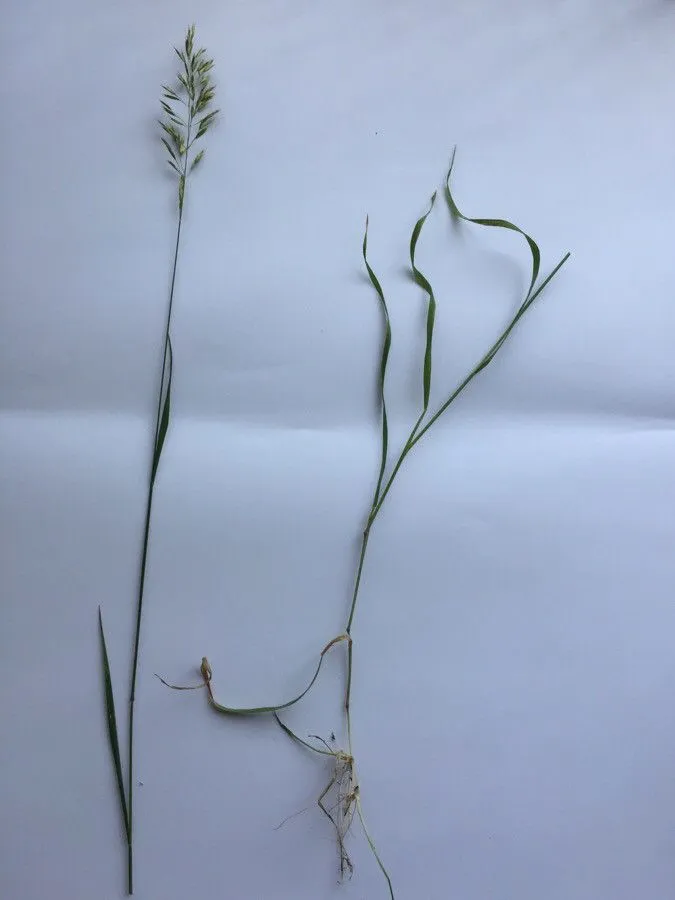
Author: (L.) P.Beauv.
Bibliography: Ess. Agrostogr.: 88 (1812)
Year: 1812
Status: accepted
Rank: species
Genus: Trisetum
Vegetable: False
Observations: Azores, Europe to Medit. and N. Iran
Yellow oatgrass, scientifically known as Trisetum flavescens, is a perennial grass that belongs to the Poaceae family. This plant is distinguished by its vibrant yellow-green hue, which not only enhances the aesthetic appeal of the meadows and pastures where it thrives but also underscores its common name.
First described in 1812 in a foundational work on grasses, Yellow oatgrass has since been recognized for its wide distribution and ecological importance. It can be found sprawling across diverse regions, from the lush landscapes of the Azores to the vast expanses of Europe, extending south to the Mediterranean and reaching as far east as northern Iran. This extensive geographical range attests to the species’ adaptive capabilities and ecological versatility.
The habitats frequented by Trisetum flavescens are often characterized by temperate climatic conditions. The grass thrives in meadows, pastures, and open woodland areas where it benefits from full sunlight and well-drained soils. Farmers and ecologists alike appreciate this species for its role in maintaining biodiversity and soil integrity, as well as its contribution to the pastoral ecosystem by providing forage for livestock.
With its graceful, fine-textured leaves and upright growth habit, Yellow oatgrass not only serves functional roles within its ecosystem but also adds a visual charm to the natural landscapes it inhabits. Recognizable by its delicate inflorescences that emerge in late spring to early summer, the plant creates a picturesque scene that resonates with the tranquillity of the countryside.
In summary, Trisetum flavescens, or Yellow oatgrass, is a resilient and attractive species of the Poaceae family that plays a critical role in the ecosystems of the Azores, Europe, the Mediterranean, and northern Iran. Its broad distribution and adaptability highlight its importance in both natural and agricultural settings, making it a grass species of notable interest to botanists, farmers, and nature enthusiasts alike.
Dan: almindelig guldhavre, glinsende guldhavre, guldhavre
Eng: golden oat grass, yellow oat grass, yellow oatgrass, yellow-oat-grass, yellow false oat, yellow oat-grass
Deu: goldhafer, wiesen-goldhafer
Por: aveia-amarela
Spa: avena amarilla, avena rubia, pasto dorado
Ita: avena bionda
Fra: avoine dorée, avoine jaunâtre, trisète jaunâtre
Nld: goudhaver
Nor: gull-havre
Swe: gullhavre
Lav: pļavas zeltauzīte
Cym: ceirchwellt melyn, ceirchwellt melynaidd
En: Yellow oatgrass, Yellow-oat-grass, Golden oat grass, Yellow oat grass, Yellow Oat-grass, Yellow false oat, Golden Oatgrass
Ca: Fromental petit
Da: Almindelig guldhavre, Glinsende guldhavre, Guldhavre
Nl: Goudhaver
Fr: Avoine dorée, Avoine jaunâtre, Trisète jaunâtre, Trisète commune
De: Goldhafer, Wiesen-Goldhafer, Gewöhnlicher Goldhafer
It: Avena bionda, Gramigna bionda
Lv: Pļavas zeltauzīte
No: Gull-havre
Pt: Aveia-amarela
Es: Avena amarilla, Avena rubia, Pasto dorado
Sv: Gullhavre
Cy: Ceirchwellt Melyn, Ceirchwellt Melynaidd
Taken Aug 15, 2020 by Maarten Vanhove (cc-by-sa)
Taken May 13, 2022 by yvon s (cc-by-sa)
Taken Jul 7, 2022 by Harry Graham (cc-by-sa)
Taken Jun 9, 2019 by Ben Ben (cc-by-sa)
Taken May 28, 2020 by Roland Garnier (cc-by-sa)
© copyright of the Board of Trustees of the Royal Botanic Gardens, Kew.
© copyright of the Board of Trustees of the Royal Botanic Gardens, Kew.
Taken Aug 15, 2022 by Heuweid Schübelbach (cc-by-sa)
Taken May 17, 2015 by Tela Botanica − Paul FABRE (cc-by-sa)
Taken May 17, 2015 by Tela Botanica − Paul FABRE (cc-by-sa)
Taken Jul 28, 2017 by REKLOV RELLÜM (cc-by-sa)
Taken Aug 4, 2019 by francois tissot (cc-by-sa)
Taken Aug 15, 2019 by Photoflora – Jean-Luc TASSET (©)
Taken Jul 15, 2018 by Photoflora – Jean-Luc TASSET (©)
Taken May 15, 2018 by Photoflora – Jean-Luc TASSET (©)
Taken Aug 15, 2021 by DEBRAS Sylvain Jardin Botanique Metz (cc-by-sa)
Taken Aug 4, 2019 by francois tissot (cc-by-sa)
Taken Aug 15, 2008 by Photoflora – Jean-Luc TASSET (©)
Taken Jul 24, 2021 by Jean-loup Deval (cc-by-sa)
Taken Aug 23, 2021 by kal l (cc-by-sa)
Taken May 13, 2022 by yvon s (cc-by-sa)
Taken Jun 14, 2014 by Tela Botanica − Martine BÉNÉZECH (cc-by-sa)
Taken May 31, 1852 by Tela Botanica − Herbier PONTARLIER-MARICHAL (cc-by-sa)
Taken Jan 1, 1800 by Tela Botanica − Daniel MATHIEU (cc-by-sa)
Taken Jan 1, 1970 by Photoflora – L’Abbé COSTE (©)
Taken Aug 15, 2006 by Photoflora – Jean-Luc TASSET (©)
Taken May 15, 2008 by Photoflora – Benoit BOCK (©)
Taken Jun 1, 2019 by Carlos Villasante (cc-by-sa)
Growth habit: Graminoid
Ph maximum: 7.5
Ph minimum: 7.0
Light: 8
Atmospheric humidity: 4
Soil nutriments: 5
Family: Myrtaceae Author: (F.Muell.) K.D.Hill & L.A.S.Johnson Bibliography: Telopea 6: 402 (1995) Year: 1995 Status:…
Family: Rubiaceae Author: Pierre ex A.Froehner Bibliography: Notizbl. Bot. Gart. Berlin-Dahlem 1: 237 (1897) Year:…
Family: Sapindaceae Author: Koidz. Bibliography: J. Coll. Sci. Imp. Univ. Tokyo 32(1): 38 (1911) Year:…
Family: Asteraceae Author: A.Gray Bibliography: Pacif. Railr. Rep.: 107 (1857) Year: 1857 Status: accepted Rank:…
Family: Fabaceae Author: Medik. Bibliography: Vorles. Churpfälz. Phys.-Ökon. Ges. 2: 398 (1787) Year: 1787 Status:…
Family: Aspleniaceae Author: (Cav.) Alston Bibliography: Bull. Misc. Inform. Kew 1932: 309 (1932) Year: 1932…